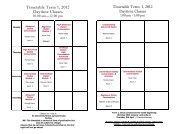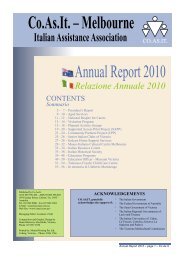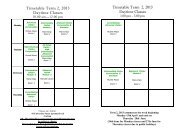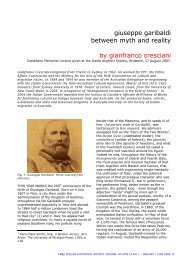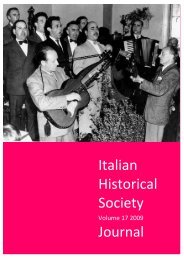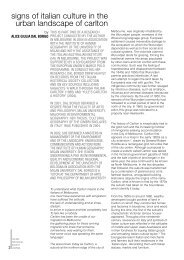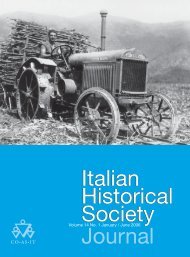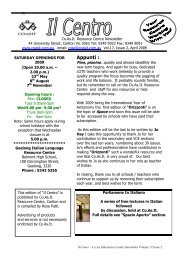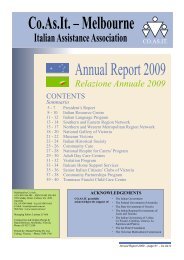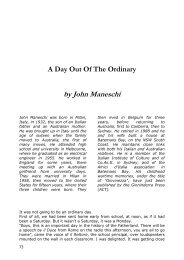January-December 2010, vol. 1
January-December 2010, vol. 1
January-December 2010, vol. 1
- No tags were found...
Create successful ePaper yourself
Turn your PDF publications into a flip-book with our unique Google optimized e-Paper software.
enabling their rubbish and night soil to be collected. At thattime, Lansdowne Place also had a number of very smalldwellings on its western side. Between 57 Bouverie Street andQueensberry Street, a distance of only about seventy metres,were three hotels, all on the same side of the street as 57. 25They were the Nugget, the Victoria and the Commercial. It musthave been a very busy block after working hours.Antonino and Giuseppa had a third child named Lorenzo, whodied while still a baby. Their fourth child, Margherita, was bornon 18 October 1900. 26 Then Lawrence was born on 26 <strong>January</strong>1902; Australia Day. 27 I think they would have been aware thatit was Australia Day as it had been celebrated since thefoundation of the colony in 1788, and especially because thefirst anniversary of Federation had occurred only a few weeksbefore Lawrence’s birth. I think they would have treated theconcurrence of the two events as more than a coincidence.They were happy and becoming established in their adoptedcountry and life must have seemed good for Antonino andGiuseppa and their young family.However, early in 1902 clouds started to appear. Antoninobecame ill. He returned home one evening from work with afierce headache. There is a family tradition that this headachefirst occurred after a meeting with a friend or acquaintance atAntonino’s fruit stall that day. Antonino’s business successseems to have been the subject of comment in his community,and perhaps the cause of a little envy. He always stocked thebest quality vegetables, fruit and flowers. His friend accostedhim, exclaiming about his success and at the same time hittinghim on the back of the head – in semi-jocular fashion nodoubt. 28Whatever the cause of Antonino’s illness, it becameprogressively worse. In desperation he decided to go back toItaly in the hope that Italian doctors might be able to cure himwhere Australian doctors had failed. It seems that in this case,in<strong>vol</strong>ving a painful and serious illness, Antonino still felt moreconfidence in resorting once again to the still familiarmotherland environment, rather than trusting the stillunfamiliar medical system of his adopted country. Moreover,he probably felt uncomfortable talking to doctors in Englishabout such a serious and distressing illness.I am not certain, but I believe Giuseppa stayed behind to lookafter Maggy and Lawrence, while young Antonio took overAntonino’s business to earn the family living. Possibly Mary wasable to get some work. While Antonino was away in Italy, therest of the family moved into No 17 Lansdowne Place. This wasactually in a side alley off the main section of Lansdowne Place.It was a fraction larger than the dwelling at No 57 BouverieStreet but with no verandah, back yard, or even its own toilet –25 State Library of Victoria (SLV): Melbourne & Metropolitan Board ofWorks (MMBW) Sewerage Detail Plan, 1896.26 Ron Costa, oral source.27 Victorian Registry of Births, Deaths and Marriages.28 Lena Santospirito, oral source.a mere hovel. 29 None of the dwellings in Lansdowne Place hadits own toilet. The residents used the several small public toiletsthat were there.Unfortunately, the Italian doctors had no more success than theAustralians. Antonino returned to Australia on the Ophir in<strong>December</strong>, 1903. Despite his illness, he was still able to lookafter a lone nine-year-old migrant from Malfa, Salvatore Russo,who had been placed in his care for the voyage. Salvatore stillremembered this kindness eighty years later. 30 On Antonino’sreturn, the family moved into No 27 Lansdowne Place. It alsowas in a side alley. It was marginally bigger than No 17 and hada very small verandah, but no yard. 31Antonino’s pain became intolerable. In the end Giuseppa, Maryand Antonio could no longer cope and on 24 November 1904,he was admitted as a patient at the Lunatic Asylum in Kew. 32This was not an unusual solution for cases like Antonino’s at thetime. There were then eight asylums in Victoria for the insaneand for dangerous lunatics. They housed hundreds of patients.“Lunatic” was defined by the Victorian Lunacy Act 1890 tomean “any person idiot lunatic of unsound mind and incapableof managing himself or his affairs.” Patients were admitted forall sorts of “mental” conditions, all classed as forms of insanity; aword used generally to describe a person of unsound mind.They included mania, dementia, delusions, general paralysis,adolescent mania, and epilepsy. Asylums at that time served asthe institutions for those with mental and neurological healthproblems.The form of insanity under which Antonino was admitted was“melancholia.” He was brought to the asylum by “friends.” Bythis time, he was in a pitiable state. On admission he wasunable to walk and had to be brought in on a stretcher. He wasblind. Giuseppa used to bring Lawrence to the asylum so hecould touch and feel him, the only way in which he couldexpress his love and loss. 33 He was delirious at times and noisy,although at other times he was coherent. He was emotionaland very depressed. He often wept. He often complained ofpain in the back of his head. His symptoms were described aspointing to “cerebellar tumour.” Antonino “took a sudden turn”on 16 June 1905 and died that day. 34 The cause of his deathwas determined, at inquest, as “Chronic Cerebral-SpinalMeningitis and Broncho-Pneumonia.” 35The period of Antonino’s illness leading up to his death musthave been a traumatic time for Giuseppa. She, Mary andAntonio had been separated from Antonino for five years when29 SLV: MMBW Sewerage Detail Plan, 1896.30 S. Russo, oral history interview, Italian Historical Society, 4 October1983, p. 13; Bonifacio Zurli, p. 378.31 SLV: MMBW Sewerage Detail Plan, 1896.32 Public Records Office Victoria (PRO): Kew Asylum Records, 1904-5.33 Lena Santospirito.34 Public Records Office Victoria (PRO): Kew Asylum Case Book.35 Victorian Registry of Births, Deaths and Marriages: Death certificate;No.5306.IHSJ ITALIAN HISTORICAL SOCIETY JOURNAL VOLUME 18 <strong>2010</strong> | 9



